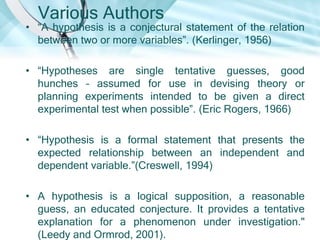
Statistical hypothesis
- 1. Various Authors • ―A hypothesis is a conjectural statement of the relation between two or more variables‖. (Kerlinger, 1956) • ―Hypotheses are single tentative guesses, good hunches – assumed for use in devising theory or planning experiments intended to be given a direct experimental test when possible‖. (Eric Rogers, 1966) • ―Hypothesis is a formal statement that presents the expected relationship between an independent and dependent variable.‖(Creswell, 1994) • A hypothesis is a logical supposition, a reasonable guess, an educated conjecture. It provides a tentative explanation for a phenomenon under investigation." (Leedy and Ormrod, 2001).
- 2. Hypothesis Theory Fact • A specific, testable • Well-established •is something which is prediction about what is principle which predicts assumed to be true expected to happen in a events in general terms study •once a theory has been • Arises from repeated confirmed and •makes a specific observation and testing reconfirmed over and prediction about a over again, we get to specified set of •Incorporates facts, the point that it will be circumstances laws, predictions, and treated as a "fact" •a speculative guess that tested hypotheses that has yet to be tested are widely accepted •doesn't mean 'absolute certainty •is new and relatively •extensively tested and untested is generally accepted •the probability of error and correction are high One common feature for facts, theories, and hypotheses in science is that they are all treated as fallible — the likelihood of error might vary greatly, but they are still regarded as something less than absolute truth.
- 3. A Hypothesis • must make a prediction • must identify at least two variables • should have an elucidating power • should strive to furnish an acceptable explanation or accounting of a fact • must be falsifiable meaning hypotheses must be capable of being refuted based on the results of the study • must be formulated in simple, understandable terms • should correspond with existing knowledge • In general, a hypothesis needs to be unambiguous, specific, quantifiable, testable and generalizable.
- 4. STATISTICAL HYPOTHESIS A statistical hypothesis is an assertion regarding the statistical distribution of the population. It is a statement regarding the parameters of the population Statistical hypothesis is denoted by H Examples: 1. H: The population has mean μ = 25 2. H: The population is normally distributed with mean μ=25 and standard deviation In a test procedure, to start with, a hypothesis is made. The validity of this hypothesis is tested. If the hypothesis is found to be true, it is accepted. On the other hand, if it is found to be untrue, it is rejected The hypothesis which is being tested for possible rejection is called null hypothesis. The null hypothesis is denoted by H0. Hypothesis which is accepted when the null hypothesis is rejected is called alternative hypothesis. The alternative hypothesis is denoted by H1
- 5. CRITICAL REGION • From a population many samples of the same size n can be drawn. Let S be the set of all such sample of size n that can be drawn from the population. • Then, S is called sample space. While testing a null hypothesis, among the samples which belong to S, some samples lead to the acceptance of the null hypothesis, whereas, some others lead to the rejection of the null hypothesis. • The set of all those samples belonging to the sample space which lead to the rejection of the null hypothesis is called critical region. • The critical region ids denoted by ω. The critical region is also rejection region. The set of samples which lead to the acceptance of the null hypothesis is the acceptance region. It is (S- ω).
